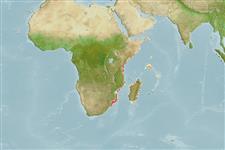Elasmobranquios (tiburones y rayas) (sharks and rays) >
Carcharhiniformes (Ground sharks) >
Pentanchidae (Deepwater catsharks)
Etymology: Bythaelurus: bythos (Gr.), depths of the sea, referring to its deepwater habitat; ailouros (Gr.), cat, probably an allusion to the vernacular “catshark,” so named for its cat-like eyes. (See ETYFish); lutarius: Latin for “of the mud,” referring to its habitat on or just above muddy bottoms at 338-766 m. (See ETYFish).
Environment: milieu / climate zone / depth range / distribution range
Ecología
marino batidemersal; rango de profundidad 338 - 766 m (Ref. 5510). Deep-water; 13°N - 29°S
Western Indian Ocean: off Mozambique (Ref. 5578) and Somalia.
Length at first maturity / Tamaño / Peso / Age
Maturity: Lm ?, range 30 - ? cm
Max length : 34.0 cm TL macho / no sexado; (Ref. 244); 39.0 cm TL (female)
Short description
Morfología | Morfometría
Espinas dorsales (total): 0; Radios blandos dorsales (total): 0; Espinas anales 0; Radios blandos anales: 0. A slender, dwarf catshark with a moderately long snout and short labial furrows; caudal fin without crest of enlarged denticles (Ref. 5578). Dull grey-brown, paler ventrally, with few poorly defined dorsal saddles that may be visible (Ref. 5510).
Found on the continental slope on or just above muddy substrates (Ref. 5578). Feeds on cephalopods, small bony fishes, and crustaceans (Ref. 5578). Probably caught with bottom trawls (Ref. 30573).
Ovoviviparous, with 2 pups per litter (Ref. 5510).
Compagno, L.J.V., 1984. FAO Species Catalogue. Vol. 4. Sharks of the world. An annotated and illustrated catalogue of shark species known to date. Part 2 - Carcharhiniformes. FAO Fish. Synop. 125(4/2):251-655. Rome: FAO. (Ref. 244)
IUCN Red List Status (Ref. 130435)
Threat to humans
Harmless
Human uses
Pesquerías: sin interés
Más información
Age/SizeCrecimientoLength-weightLength-lengthLength-frequenciesMorfometríaMorfologíaLarvaDinámica larvariaReclutamientoAbundanciaBRUVS
ReferenciasAcuiculturaPerfil de acuiculturaRazasGenéticaElectrophoresesheritabilidadEnfermedadesProcesamientoNutrientsMass conversion
ColaboradoresImágenesStamps, Coins Misc.SonidosCiguateraVelocidadTipo de nataciónSuperficie branquialOtolitosCerebrosVisión
Herramientas
Special reports
Download XML
Fuentes de Internet
Estimates based on models
Preferred temperature (Ref.
123201): 9.4 - 12.4, mean 11.4 °C (based on 17 cells).
Phylogenetic diversity index (Ref.
82804): PD
50 = 0.5001 [Uniqueness, from 0.5 = low to 2.0 = high].
Bayesian length-weight: a=0.00355 (0.00176 - 0.00714), b=3.09 (2.91 - 3.27), in cm total length, based on LWR estimates for this (Sub)family-body shape (Ref.
93245).
Nivel trófico (Ref.
69278): 4.2 ±0.56 se; based on food items.
Resiliencia (Ref.
120179): Muy bajo, población duplicada en un tiempo mínimo superior a 14 años (Fec=2).
Fishing Vulnerability (Ref.
59153): Low to moderate vulnerability (29 of 100).
